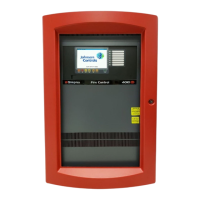page 57 579-1150 Rev M
4010ES IDNAC Fire Alarm System Installation Guide
7.2.4 Class B wiring to devices
To connect the ESS IDNAC terminal block to appliances using Class B wiring:
1. Route the wire from the “+” and the “-” outputs on the IDNAC SLC terminal blocks (TB1, TB2 or TB3) to the appropriate inputs on a
peripheral notification appliance.
2. Route wire from the first appliance to the next one. “T” tapping is allowed. Repeat for each appliance.
3. Repeat steps 1 through 3 for each IDNAC SLC output you want to use.
Note:
a. Notification appliances are rated per individual nameplate label. Maintain correct polarity on terminal connections.
b. Each IDNAC + and - terminal is rated for 2 identical wires. This allows up to 4 Class B T-TAP circuits directly from each
IDNAC terminal block. See Figure 46.
Figure 46: Class B wiring
7.2.5 Calculating ClassB wiring with isolators
When using isolators, the maximum wire distance of each of these SLC branches from panel to any device is the smaller of the values
obtained from Figure 45, and the Equation 1. See Table 31 for the ohms per 1000 ft.
Note: Each IDNAC + and - terminal is rated for 2 identical wires. This allows up to 4 Class B T-TAP circuits directly from each IDNAC termi-
nal block. See Figure 42.
Equation 1: Maximum SLC wire branch length based on appliance alarm current load
• Add the alarm loads of all the devices on an SLC wire branch and apply to Equation 1.
• Add the unit loads for all devices on an SLC wire branch and the number of isolators and apply UTP wiring limit as described in Figure
45.
Maximum wire resistance protected by 1 isolator is 1.5 ohm (total, both wires).
Wire the devices as instructed in Class B wiring to devices.

